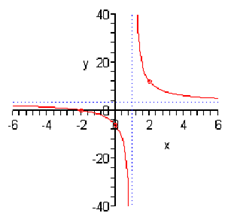Sketch the graph of function.
f ( x ) =3x + 6 /x -1
Solution
Thus, we'll start off with the intercepts. The y-intercept is,
f (0) =6/-1=-6⇒ (0, -6)
The x-intercepts will be,
3x + 6 = 0
x = -2 ⇒ ( -2, 0)
Now, we have to determine the asymptotes. Let's first determine the vertical asymptotes.
x -1 =0 ⇒ x = 1
Thus, we've got one vertical asymptote. It means that now there are two regions of x's. They are x < 1 and x > 1 .
Now, the largest exponent within the numerator & denominator is 1 and thus by the fact there will be a horizontal asymptote at the line.
y = 3/1 = 3
Now, we only need points in each region of x's. As the y-intercept & x-intercept are already in the left region we won't have to get any points there. It means that we'll only need to get a point in the right region. It doesn't actually matter what value of x we pick here we only have to keep it rather small so it will fit onto our graph.
f ( 2) = 3( 2) + 6/2 -1 = 12 /1= 12 ⇒ ( 2,12)
Putting all this together illustrate the following graph.
